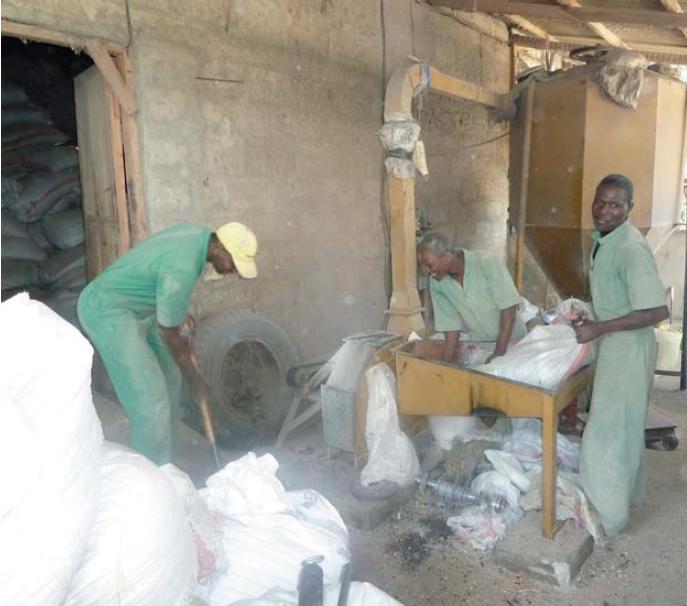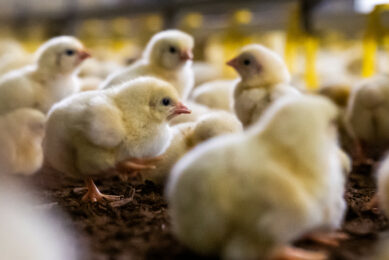A lot to gain in small scale African feed management

In the last 20 years egg production in Africa increased by one million tonnes with more and more countries starting their own production. In times of soaring raw material prices farmers have to reach a high productivity of their flocks with lowest mortality. This article is aiming to help achieve this goal by focusing on the proper manufacturing and use of compound feed, one of the two most important points, next to chick management.
Throughout their life chicken have different nutrient requirements and only if these needs are fulfilled can they grow to their genetic potential. Many farmers in Africa mix their feed themselves which appears to be cheaper, but can be an expensive experience in the long run. Raw materials must be analysed for their nutrient content regularly, especially when regional by-products are used. Only based on this information can a formulation be calculated, otherwise the feed might not contain the necessary nutrients. All European countries have laboratories for agricultural purposes, for Germany just google LUFA Germany and you will find several German labs or for England go to the website: www.food.gov.uk/enforcement/monitoring/foodlabs/foodcontrollabs for a list of official food control laboratories in the UK.
Since raw material prices are rising, alternative feedstuffs for poultry feeds can be a solution, if the nutritional value is known. In Table 1 and 2 most raw materials with their nutritional impact have been listed. Some raw materials are described as ‘high fibre’. Based on new scientific literature and a lot of practical experience from different countries around the world crude fibre will not harm any layer bird, neither during rearing (developer phase for instance) nor during the production period as long as energy content of the feed is not being reduced. An increased content of crude fibre can even support a healthy digestion and very often will influence birds’ behaviour positively.
High feed density required
If the chickens are housed in environmentally controlled units, feeding formulations and methods can work as in moderate parts of the world. Many houses in Africa though are open houses with no temperature control except fans and occasionally foggers for cooling. The chickens are more or less exposed to the outside heat. With increasing temperatures, birds reduce their feed intake to decrease the metabolic heat produced by digesting the feed whilst at the same time the energy required to cool down and maintain the body temperature of 40-41°C will increase. Therefore special measurements have to be implemented and it is very important that the feed density is high. Unfortunately the reality in Africa is often different.
Many feeds do not have the required nutrient level but at the same time the management is giving the lowest amount of feed referring to the breeder management guides without taking into consideration the feed quality. For example the birds are only given a daily ratio of 105 g/bird, which is stated as one option in the management guide. However, the feed does not meet the requirements of 17.81% protein (Lohmann feed for layers week 19-45), but only contains 16% protein. Thus, the bird will need to consume more feed in order to meet its requirement of 18.70 g protein and 11.4 MJ ME per day. As a rule of thumb a layer held in hot climates should never be restricted in feed uptake, but fed ad lib.
The easiest way to add energy to the feed is through oil and fat, which will also help to maintain a good palatability of the mash structure. Palm oil or soy oil is recommended. The feed should be consumed shortly after mixing the oil to avoid rancidity problems.
Feeding methods
In the first six weeks of their life chicks undergo the fastest body weight increase which needs to be supported with a dense and rich feed, containing a high amount of protein, amino acids and energy. For detailed information the breed supplier should be consulted. It is absolutely necessary to check the body weight of the pullets during rearing as well as in the first weeks of production and compare it to the standard body weight of the breed. Weigh a minimum of 100 birds per house once a week, keep records and make sure the body weight at 17 weeks is in line with the recommended weight in the management guide.
This stage is followed by a period of slower development. During pre-peak and early peak periods layers are often not able to consume enough feed to meet their nutrition requirements which will cause mortality and low production. Therefore this period of slow bodyweight increase from week 9-16 can be used to train the pullets for high feed intake capacity and good appetite through the usage of a less dense feed in terms of protein, amino acids and calcium, enriched with a high amount of crude fibre of up to 5%, or even higher which will not harm the pullets as long as the energy will not be reduced. This training can be supported by a meal feeding regime which forces the birds to empty the feeders once a day, preferably during the hottest part of the day and will stimulate the appetite. Keep in mind that the feed has to be changed according to body weight and not in a time frame.
Pre-Layer diets from week 17 to 5% of production are a good tool to support these birds which are already starting to lay eggs and to stimulate the rest of the flocks, but only few farmers in Africa are using them since they are worried about the additional work or consider it too complicated. In this case one can simply use the normal developer diet and adjust it to 2% of calcium, by adding roughly 2.5% of coarse limestone on top of the developer feed.
During the production phase three different feeding programs from 19-45 weeks, 46-65 weeks and after 65 weeks should be used in order to support the birds changing requirements, also a rare practice in Africa. If these programs are not implemented, at least 5 g of coarse calcium/bird/day should be offered to the layers after week 45, preferably in the afternoon/evening feeding to maintain good shell quality and liveability.
An energy level of 11.4-11.6 MJ ME or 2,725-2,770 Kcal (based on a German energy evaluation system) has to be maintained in all layer feeds and the correct percentage of protein according to the breeders’ recommendations. The feed should be distributed as one-third in the morning and two-thirds in the evening, since the layer needs the energy and the calcium for egg formation during the night.











